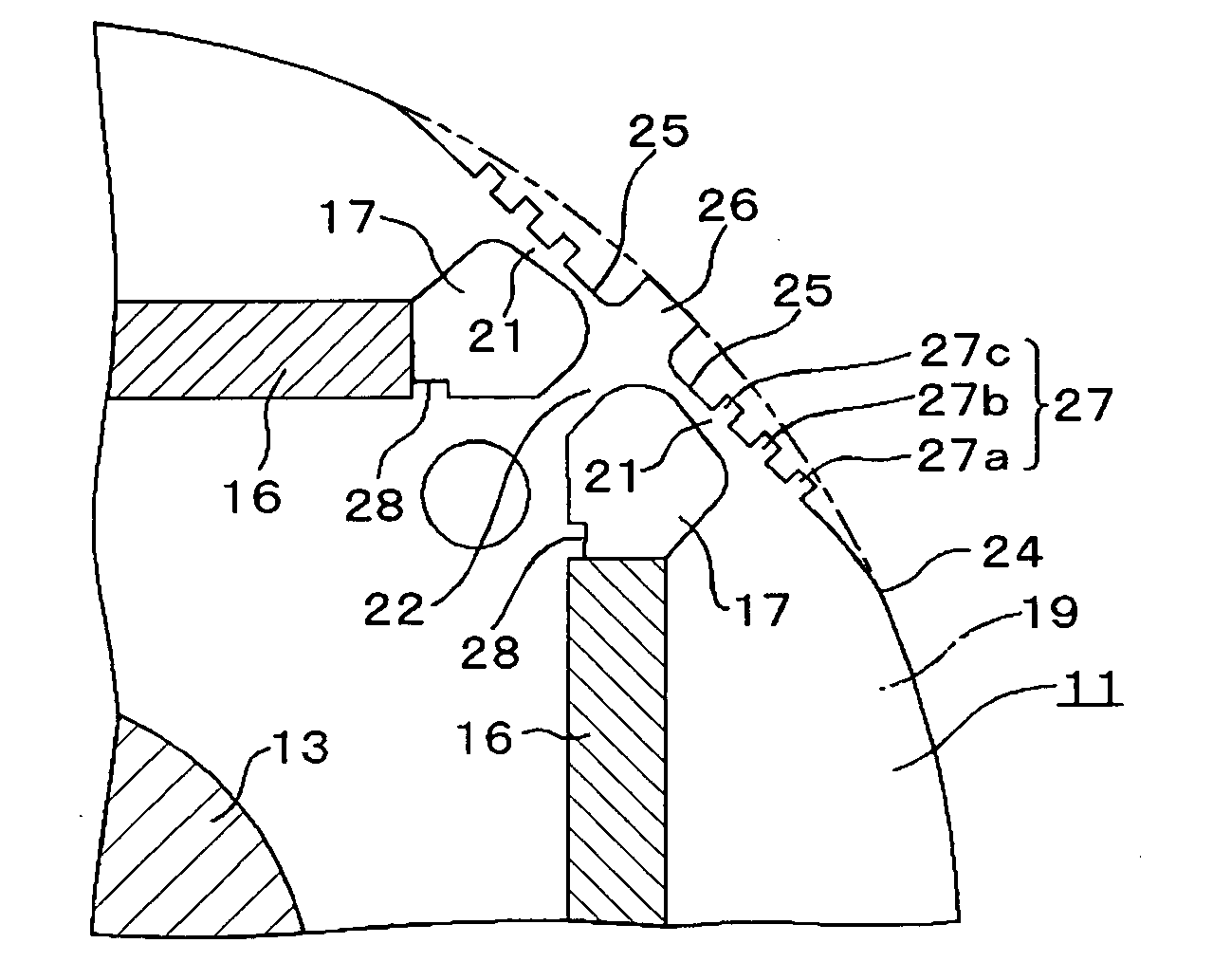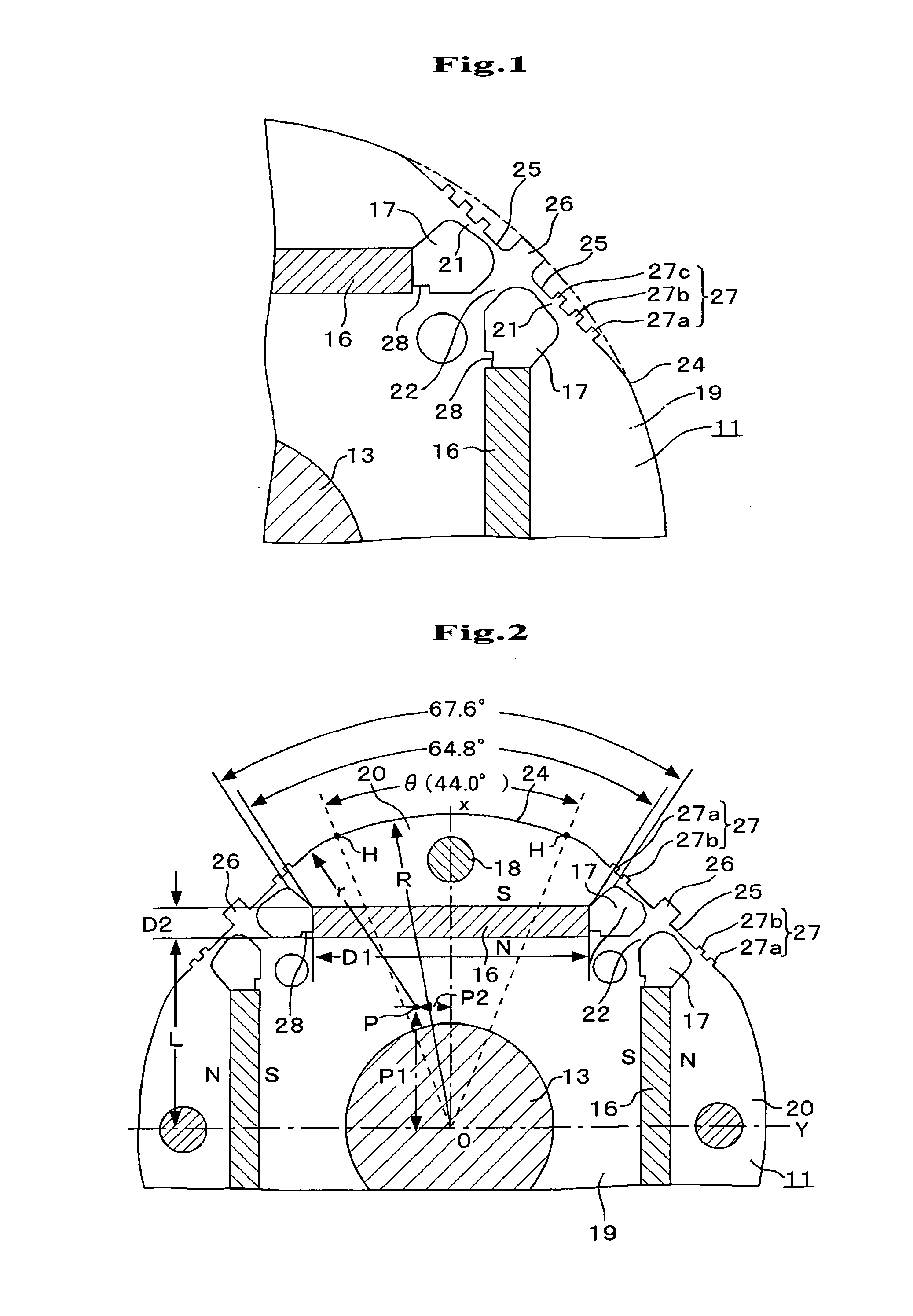Magnet Embedded Rotor, Electric Motor Using the Same Rotor, and Compressor Using the Same Motor
a technology of embedded rotors and electric motors, which is applied in the direction of magnetic circuit rotating parts, magnetic circuit shapes/forms/construction, piston pumps, etc., can solve the problems of iron loss occurring at the rotation of electric motors, reducing efficiency, and flux increasing calking torque, so as to increase the output torque of electric motors, reduce calking torque, and reduce the variation in magnetic flux density
- Summary
- Abstract
- Description
- Claims
- Application Information
AI Technical Summary
Benefits of technology
Problems solved by technology
Method used
Image
Examples
embodiment 1
[0050]Embodiments of the present invention are described below, based on the drawings.
[0051]In FIGS. 1 and 2, a rotor 11 comprises the iron core of the rotor in which multiple silicon steel plates are laminated, four permanent magnets 16, a rotation axis 13 at the center and rivets for fixation 18 at four sites near the outer face.
[0052]In iron core 19 of said rotor, said permanent magnets 16 are the long hand D1 (e.g. 26.5 mm)×the short hand D2 (e.g. 2.8 mm) in size with the radius R (e.g. 30.00 mm) and embedded at a distance L (e.g. 18.02 mm) in parallel to the axes X and Y passing through the central point 0. The salient poles comprise outer faces 24 corresponding to the long hands of the permanent magnets. At both the edges of these permanent magnets 16, non-magnetic parts 17 including the void for preventing the short circuit of the magnetic flux are formed and reinforced rib parts 22 are between the adjacent two non-magnetic parts 17. The first protruding part 26 is formed at ...
embodiment 2
[0064]FIG. 3 shows Embodiment 2 of the present invention in which permanent magnets 16 are arranged in a V-letter shape. When the permanent magnets 16 are arranged in a V-letter shape, the output improves, but the effect to reduce the calking torque and vibration / noise (torque ripple) which are the objects of the present invention, is hardly different from that in Embodiment 1. The other configurations are not different from those in FIG. 2.
[0065]FIG. 4 (a) shows an enlarged view of FIG. 3 with two second protruding parts 27a and 27b. FIG. 4 (b) shows an embodiment in which the one second protruding part 27a rises up sharply at both the sides and FIG. 4 (c) shows an embodiment in which the one second protruding part 27a rises up smoothly at both the sides.
[0066]The experimental action and effect of the rotor 11 (FIGS. 3 and 4) in Embodiment 2 are described in FIG. 11.
[0067]As for calking torque, the embodiment with the one second protruding part 27 which is smooth as shown in FIG. 4...
PUM
 Login to View More
Login to View More Abstract
Description
Claims
Application Information
 Login to View More
Login to View More - R&D
- Intellectual Property
- Life Sciences
- Materials
- Tech Scout
- Unparalleled Data Quality
- Higher Quality Content
- 60% Fewer Hallucinations
Browse by: Latest US Patents, China's latest patents, Technical Efficacy Thesaurus, Application Domain, Technology Topic, Popular Technical Reports.
© 2025 PatSnap. All rights reserved.Legal|Privacy policy|Modern Slavery Act Transparency Statement|Sitemap|About US| Contact US: help@patsnap.com



